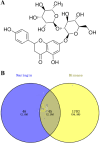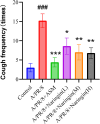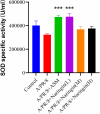Activity and mechanism of naringin in the treatment of post-infectious cough
- PMID: 40634934
- PMCID: PMC12243327
- DOI: 10.1186/s12890-025-03788-6
Activity and mechanism of naringin in the treatment of post-infectious cough
Abstract
Objective: To explore activity and mechanism of naringin in the treatment of PIC (Post-Infectious Cough) by virtue of network pharmacology and animal studies.
Methods: The targets associated with naringin were obtained from the SwissTargetPrediction and Super-PRED databases. Disease-related targets were collected from GeneCards and OMIM (Online Mendelian Inheritance in Man). Venny was utilized to identify the overlapping targets between naringin and the disease. PPI (Protein-Protein Interaction) networks for disease-related targets were constructed using STRING and Cytoscape 3.10.1. GO (Gene Ontology) functional annotation and KEGG (Kyoto Encyclopedia of Genes and Genomes) pathway enrichment analyses were performed with Metascape. Molecular docking between key targets and naringin was conducted using AutoDock Vina. In the animal experiments, PIC models were established in guinea pigs via intranasal inoculation with A/PR/8 virus, and cough frequency was measured after citric acid-induced coughing. Morphological changes in lung tissue and airways were assessed using the HE (Hematoxylin-Eosin) staining method. The relative expression levels of IL-8 (Interleukin-8), IL-1β (Interleukin-1β), TNF-α (Tumor Necrosis Factor-Alpha), and NF-κB p65 (Nuclear Factor Kappa-B p65 Subunit) mRNA were analyzed by RT-qPCR (Reverse Transcription Quantitative Polymerase Chain Reaction). SOD (Superoxide Dismutase) activity in lung tissue was measured using a colorimetric assay.
Results: After screening, naringin may contribute to the treatment of post-infectious cough by targeting proteins expressed by core genes such as HSP90AA1 (HSP 90-Alpha), TLR4 (Toll-like Receptor 4), MTOR (Mechanistic Target of Rapamycin), HIF1A (Hypoxia-Inducible Factor Alpha), and NF-κB1 (Nuclear Factor Kappa-B Subunit 1). KEGG enrichment analysis revealed involvement in pathways including the HIF-1 (Hypoxia-Inducible Factor 1) signaling pathway and the PD-L1 (Programmed Death-Ligand 1) expression and PD-1 (Programmed Cell Death Protein 1) checkpoint pathway in cancer. Molecular docking results indicated that naringin exhibited strong binding affinity with HSP90AA1, TLR4, MTOR, HIF1A, NF-κB1, NOS3 (Nitric Oxide Synthase 3), and GRB2 (Growth Factor Receptor-Bound Protein 2). In animal experiments, compared to the normal group, guinea pigs in the model group exhibited a significantly higher number of coughs, pronounced lung tissue hyperplasia, and inflammatory cell infiltration. Additionally, the relative expression of IL-8, IL-1β, TNF-α, and NF-κB p65 mRNA was significantly increased, while lung tissue SOD activity was decreased. Treatment with naringin significantly reduced the number of coughs, attenuated pathological changes in lung tissue, lowered the lung index, decreased the relative expression of IL-8, IL-1β, TNF-α, and NF-κB p65 mRNA, and significantly increased SOD activity in lung tissue compared to the model group.
Conclusion: Naringin shows therapeutic potential to alleviate PIC symptoms in a guinea pig model through anti-inflammatory and antioxidant mechanisms.
Keywords: Anti-inflammatory; Antioxidant; Naringin; Network pharmacology; Post-infectious cough.
© 2025. The Author(s).
Conflict of interest statement
Declarations. Ethics approval and consent to participate: All experimental procedures involving animals were carried out in accordance with the protocols approved by the Animal Experiment Com-mittee (W230020) of the Experimental Animal Center, Zhongshan Devel-opment Zone Laboratory, China National Analytical Center in Guangzho-u. Consent for publication: Not applicable. Competing interests: The authors declare no competing interests.
Figures










Similar articles
-
Mechanism of Keke tablets in treating post-infectious cough following influenza A virus infection based on network pharmacology, molecular docking, molecular dynamics and in vivo experiments.Int Immunopharmacol. 2025 Jun 25;162:115123. doi: 10.1016/j.intimp.2025.115123. Online ahead of print. Int Immunopharmacol. 2025. PMID: 40570565
-
Solidago decurrens Lour. controls LPS-induced acute lung injury by reducing inflammatory responses and modulating the TLR4/NF-κB/NLRP3 signaling pathway.J Ethnopharmacol. 2025 Jun 18;352:120172. doi: 10.1016/j.jep.2025.120172. Online ahead of print. J Ethnopharmacol. 2025. PMID: 40553825
-
Identification of components in scorpion and centipede traditional Chinese medicine formulations with potentially beneficial actions in asthma: network pharmacology and molecular docking.Hereditas. 2025 Jul 2;162(1):120. doi: 10.1186/s41065-025-00490-9. Hereditas. 2025. PMID: 40605076 Free PMC article.
-
Study on the mechanism of Shujin Tongluo granules in treating cervical spondylosis based on network pharmacology and molecular docking.Medicine (Baltimore). 2023 Jul 21;102(29):e34030. doi: 10.1097/MD.0000000000034030. Medicine (Baltimore). 2023. PMID: 37478234 Free PMC article.
-
Exploring the mechanism of ShenGui capsule in treating heart failure based on network pharmacology and molecular docking: A review.Medicine (Baltimore). 2024 Apr 5;103(14):e37512. doi: 10.1097/MD.0000000000037512. Medicine (Baltimore). 2024. PMID: 38579077 Free PMC article. Review.
References
-
- Li FY, Deng Z. Progress in the pathogenesis of post-infectious persistent cough. Zhonghua Jie He He Hu Xi Za Zhi. 2022;45(2):213–7. - PubMed
-
- Asthma Group of Chinese Thoracic Society. Chinese national guide line on diagnosis and management of cough (2021). Chin J Tuberc Respir Dis. 2022;45(1):13–46. - PubMed
-
- Lu J, Shi WH, Zhang P, et al. Application of insect traditional Chinese medicine in cough after infection based on collateral disease theory. Shanghai J Tradit Chin Med. 2022;56(7):11–3, 37.
MeSH terms
Substances
LinkOut - more resources
Full Text Sources
Medical
Research Materials
Miscellaneous

